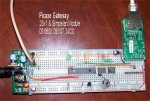lbenson
Senior Member
http://www.omnibuslinx.com:7979
The above link is to a SimpleLan hosted web site, with a picaxe-powered (28X1) back end. It is offered as one way to realize Dr_Acula's proposal for a world-wide network of picaxe networks (tho it could connect to any microprocessor network).
This is only a partial, and tentative implementation. At its heart, it relies upon the internet UDP protocol to receive and transmit messages. The web site is relatively self-documenting. It has links for message format documentation, a simple schematic, UDP talker and listener code for the PC, and an option for simulating a UDP message for the gateway to act upon, all hosted on the SimpleLan module. I would host the picaxe code as well, except that the SimpleLan only has 31K of web storage, and with the other pages, the code text, at over 660 lines and nearly 20K, would overflow the storage.
Provision has been made for Dr_Acula-style and Kranenborg-style messages, as well as messages understood by the local attached picaxe. There is no picaxe network currently connected, but the gateway can respond to messages to supply the date, the time, and the temperature by reading local sensors (DS1307 and DS18B20), and can simulate the toggling of switches in response to messages.
Intended future development:
1. add a picaxe network.
2. proceed further with the relaying of messages when the network picaxe doesn't know the ip of the site to which it is sending the message (but the gateway does).
3. log all messages
4. parts list (28X1, SimpleLan, DS1307, DS18B20, 24c32, etc.)
5. improve error handling
The web site may be reached at http://www.omnibuslinx.com:7979. The Simplelan sends and receives only on port 22002. A UDP message in the proper format sent to 69.17.65.22 will respond according to the message sent. It will be necessary to refresh the screen on the web site to see the results.
Note that this implementation is only meant as an example. Anyone actually having devices to control remotely is not likely to want to have the interface this open and unprotected. To make this more of a black box, one could simply do away with the web interface and somehow encode the messages, perhaps using some kind of daily cipher change.
The presentation is not glitch-free--sometimes the site appears unavailable, but usually a refresh will bring it up again. It is most likely to fail in presenting graphics--the schematic or the little "on" and "off" switch setting indicators. Retrying will usually work.
Thanks to all contributors on the picaxe forum. After a career in software, the past eleven months on the hardware side have been quite a learning experience for me.
Any suggestions are welcome.
Lance
The above link is to a SimpleLan hosted web site, with a picaxe-powered (28X1) back end. It is offered as one way to realize Dr_Acula's proposal for a world-wide network of picaxe networks (tho it could connect to any microprocessor network).
This is only a partial, and tentative implementation. At its heart, it relies upon the internet UDP protocol to receive and transmit messages. The web site is relatively self-documenting. It has links for message format documentation, a simple schematic, UDP talker and listener code for the PC, and an option for simulating a UDP message for the gateway to act upon, all hosted on the SimpleLan module. I would host the picaxe code as well, except that the SimpleLan only has 31K of web storage, and with the other pages, the code text, at over 660 lines and nearly 20K, would overflow the storage.
Provision has been made for Dr_Acula-style and Kranenborg-style messages, as well as messages understood by the local attached picaxe. There is no picaxe network currently connected, but the gateway can respond to messages to supply the date, the time, and the temperature by reading local sensors (DS1307 and DS18B20), and can simulate the toggling of switches in response to messages.
Intended future development:
1. add a picaxe network.
2. proceed further with the relaying of messages when the network picaxe doesn't know the ip of the site to which it is sending the message (but the gateway does).
3. log all messages
4. parts list (28X1, SimpleLan, DS1307, DS18B20, 24c32, etc.)
5. improve error handling
The web site may be reached at http://www.omnibuslinx.com:7979. The Simplelan sends and receives only on port 22002. A UDP message in the proper format sent to 69.17.65.22 will respond according to the message sent. It will be necessary to refresh the screen on the web site to see the results.
Note that this implementation is only meant as an example. Anyone actually having devices to control remotely is not likely to want to have the interface this open and unprotected. To make this more of a black box, one could simply do away with the web interface and somehow encode the messages, perhaps using some kind of daily cipher change.
The presentation is not glitch-free--sometimes the site appears unavailable, but usually a refresh will bring it up again. It is most likely to fail in presenting graphics--the schematic or the little "on" and "off" switch setting indicators. Retrying will usually work.
Thanks to all contributors on the picaxe forum. After a career in software, the past eleven months on the hardware side have been quite a learning experience for me.
Any suggestions are welcome.
Lance
Attachments
-
84.9 KB Views: 189
Last edited:

